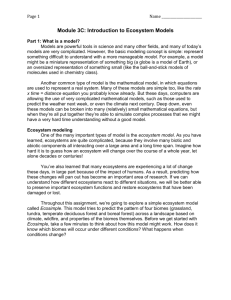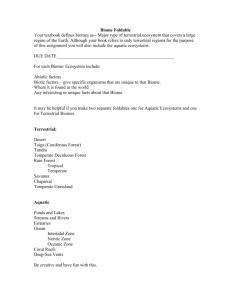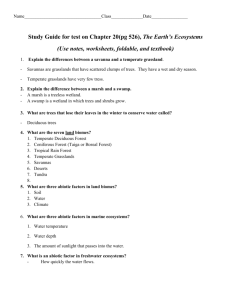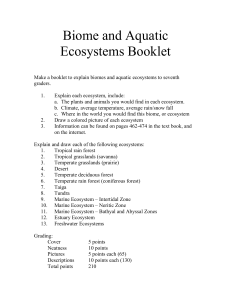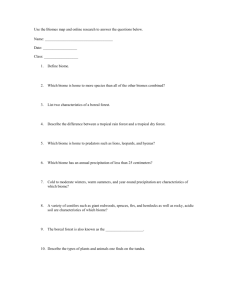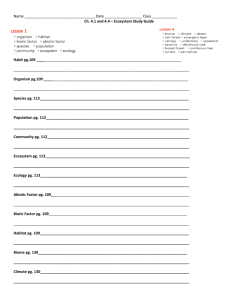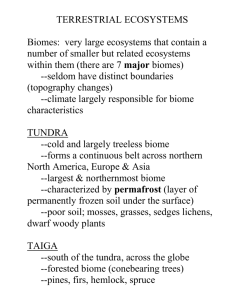Module 3C1A: Distribution of the World`s Biomes: Introduction to
advertisement
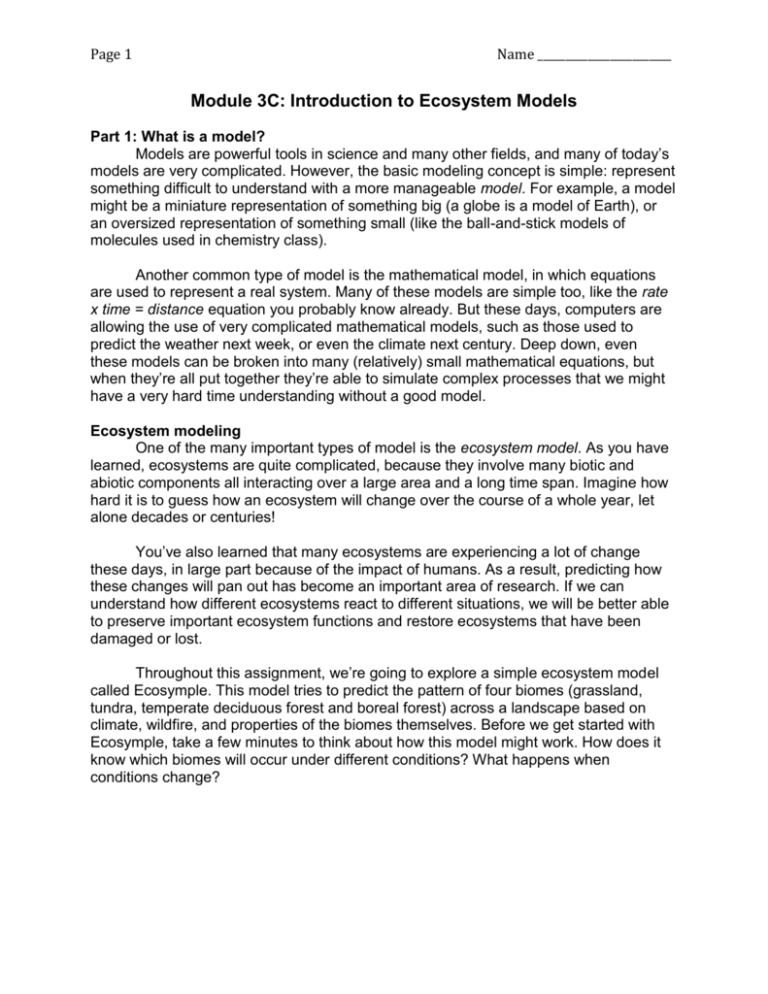
Page 1 Name ________________________ Module 3C: Introduction to Ecosystem Models Part 1: What is a model? Models are powerful tools in science and many other fields, and many of today’s models are very complicated. However, the basic modeling concept is simple: represent something difficult to understand with a more manageable model. For example, a model might be a miniature representation of something big (a globe is a model of Earth), or an oversized representation of something small (like the ball-and-stick models of molecules used in chemistry class). Another common type of model is the mathematical model, in which equations are used to represent a real system. Many of these models are simple too, like the rate x time = distance equation you probably know already. But these days, computers are allowing the use of very complicated mathematical models, such as those used to predict the weather next week, or even the climate next century. Deep down, even these models can be broken into many (relatively) small mathematical equations, but when they’re all put together they’re able to simulate complex processes that we might have a very hard time understanding without a good model. Ecosystem modeling One of the many important types of model is the ecosystem model. As you have learned, ecosystems are quite complicated, because they involve many biotic and abiotic components all interacting over a large area and a long time span. Imagine how hard it is to guess how an ecosystem will change over the course of a whole year, let alone decades or centuries! You’ve also learned that many ecosystems are experiencing a lot of change these days, in large part because of the impact of humans. As a result, predicting how these changes will pan out has become an important area of research. If we can understand how different ecosystems react to different situations, we will be better able to preserve important ecosystem functions and restore ecosystems that have been damaged or lost. Throughout this assignment, we’re going to explore a simple ecosystem model called Ecosymple. This model tries to predict the pattern of four biomes (grassland, tundra, temperate deciduous forest and boreal forest) across a landscape based on climate, wildfire, and properties of the biomes themselves. Before we get started with Ecosymple, take a few minutes to think about how this model might work. How does it know which biomes will occur under different conditions? What happens when conditions change? Page 2 Name ________________________ 1. In the space provided, sketch and label your conception of how the simple biome model like Ecosimple might work... Page 3 Name ________________________ Part 2: Getting started with Ecosimple Go ahead and open up Ecosimple on your computer. Take some time to play around with the controls and see what each one does and how the model ecosystems respond. For detailed information about the model, click the “Information” tab at the top of the model window. (If you’re interested, you can also look at the computer code that makes the model work under the “Procedures” tab.) When you are ready to continue, use Ecosimple to complete the activities below. How does it work? Now that you’ve gotten the general idea of how the model works, start exploring more carefully to figure out the details. Try methodically adjusting Ecosimple’s controls one at a time, and pay attention to the conditions that give rise to the different biomes. As you do so, create a new schematic of how the model works (next page), this time based on your observations. Try to be as detailed as possible. Page 4 Name ________________________ 2. In the space provided, sketch and label a schematic of Ecosimple based on your observations... Page 5 Name ________________________ Part 3: Randomness in models One important characteristic of any model is whether it’s stochastic (partially or completely random) or deterministic (always behaves the same way as long as the controls are set the same way). Ecosimple can be either, depending on the settings. 3. For each setting below, determine whether Ecosimple behaves as a deterministic or stochastic model. Provide support for your choice—which aspects of the model are random? a) Suppress_Fire: off, Climate_Variability: on Stochastic. Fire locations and spread are random, as is the type of biome that regrows after fire or climate-induced death. Note that everything in the model still follows rules and equations—stochastic models aren’t completely random, or they’d be useless. b) Suppress_Fire: on, Climate_Variability: off Deterministic. With the model’s two random elements turned off, its behavior is completely determined by the equations that govern it. 4. What do you think are the pros and cons of each type of model? A stochastic model is often more realistic, but it can’t give you an exact prediction, only a set of “likely” outcomes. (Usually, stochastic models are run hundreds or thousands of times in order to get an idea of the range of possibilities and the most likely outcome of all.) Deterministic models are simpler and give a single useful result for any set of inputs. As an example, physics equations are deterministic models. Imagine how annoying it would be if you had to do 10,000 simulations of random molecular movement every time you wanted to know how long it would take a ball to fall from the top of a bridge. In this case, since the model is very good and the random variations miniscule, a stochastic model would usually be a mere nuisance. Page 6 Name ________________________ Part 4: Scenarios modeling 6. Use the model to explore the following scenarios and answer questions about each. Set up the model with the conditions given in parentheses, and let it run for awhile before proceeding (this is called “spin-up” and it’s meant to keep modelers from interpretting the weird behavior of a model that’s just getting started): a) Arctic warming (T = 2.0°C; P = 50 cm; Suppress_Fire = OFF; Climate_Variability = ON) The arctic is expected to warm ~5°C by 2100 AD. Starting with the typical boreal climate defined above, gradually increase temperature by 5°C over roughly 100 years. i. Describe the landscape (biome types, fire, etc.) before, during, and after warming: We start with almost pure boreal forest. Warming leads to increasing presence of grass and deciduous trees, until a typical deciduous forest biome is reached after 100 years of warming. This probably will actually happen in much of the arctic, although it may take longer for deciduous trees to move in and completely outcompete boreal species, many of which have fire-adapted cones which give them a leg up after a burn. ii. Since Ecosimple doesn’t simulate animals, speculate on how the animal community might change under this warming scenario: Many animals are carefully adapted to their surroundings, which usually change only slowly. As the forest shifts from boreal to deciduous, some animals that live there now will probably be less suited to their environment, and thus become less abundant, become extinct, or migrate to other more suitable regions. At the same time, species that would have found the boreal forest too cold today might move in and thrive in the warmer, deciduous landscape. b) Fire Suppression (T = 2.0°C; P = 50 cm; Suppress_Fire = OFF; Climate_Variability = ON) These days, humans manage many natural wildfires to protect property and to achieve desired ecological results. One important consideration for fire managers is that forests tend to become more flammable as they age, due to the accumulation of dead fuel wood. Let the model spin up, then turn fire suppression off for about 50 years, then let a fire start. You may need to slow down the model (slider at top) or run it one step at a time (unclick GO to pause, then use “step one year” button). i. What might happen in the boreal forest if fires were completely suppressed for 50 years, but then a single one starts by accident? Page 7 Name ________________________ That fire could be huge compared to typical ones! This effect played a role in famous, record-setting fires in Yellowstone in 1988. c) Delicate balance (T = 9.0°C; P = 46 cm; Suppress_Fire = OFF; Climate_Variability = ON) Ecosystems are not always controlled directy by climate. Observe the prairie-like ecosystem described above for awhile before briefly suppressing all fires (perhaps there were several very rainy years in a row). i. What happens to the original system, and what prevents the landscape from returning to its original state? It becomes a deciduous forest, which is too inflammable to burn back into a grassdominated ecosystem. ii. For extra credit, figure out how to return the grassland to its proper form using only “prescribed burns” (mouse-clicks). Describe your method. Prescribed burning is in reality a common management tool for maintaining grassland ecosystems that no longer naturally catch fire due to human intervention. With enough clicking, students can set in motion a chain reaction of fires that can eventually sustain themselves (they need to get big enough to repeatedly get struck by the random “lightning” ignitions before growing back into forest), returning the landscape to its initial state. Page 8 Name ________________________ Part 5: Models aren’t perfect “ALL MODELS ARE WRONG, BUT SOME ARE USEFUL.” – George Box, famous statistician As useful as models often are, they’re never perfect. That’s not a bad thing really, because the purpose of a model is to be a simplified representation of reality, and if it includes every detail perfectly, then it’s no longer simplified! However, when working with a particular model it is important to understand that model’s limitations, and to correct any problems with the model if you think they might be having significant effects on your predictions. 7. Ecosimple is a very basic model, but it was still designed to be as accurate as possible. How well do you think it works? Evaluate the overall strengths and weaknesses of the model based on your explorations: There are many weaknesses, but the model is simple and works fairly well to simulate its crude, four-biome system. 8. a) Explain one specific unrealistic result from the model: There are many answers. b) Why do you think the model produces the wrong result in this case? There are many answers. c) What changes would you make to fix this error and improve Ecosimple? There are many answers.

